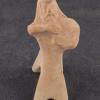Terracotta 'Persian rider' from Al Mina (3D)
Terracotta 'Persian rider' from Al Mina
Terracotta horse and rider, hand-modelled with mouldmade face. Buff core with cream slip; traces of red and black paint; discoloured overall by burning. The rider is fused with the foreparts of the horse, whose head is hand-modelled with raised mane, projecting ears and applied pellet eyes; the lower body of the horse is wedge-shaped with a divided base to represent the hooves; the equally stylized rear legs project at the back (now broken). The rider has neither arms nor legs; mouldmade face with delicate features, framing beard and browline of hair; cap or hood (kyrbasia?) with top folded over. From Al Mina, M28 Level 2 (fourth century BC).
0.15m x 0.04m.
P.R.S. Moorey, Ancient Near Eastern Terracottas (2005), p.232 no. 371 (Ashmolean 1937.746)
Commentary
'Persian rider' figurines are very common in Syria and the Levant throughout the fifth and fourth centuries BC: for a general discussion, see P.R.S. Moorey, ‘Iran and the West: the case of the terracotta ‘Persian’ riders’, in Variatio Delectat: Iran und der Westen, Gedenkschrift für Peter Calmeyer (2000), 469-486, with this example illustrated as Plate III. On early figurines of this type, the rider and horse are clearly distinguished; by the fourth century BC, man and horse tend to fuse together into a centaur-like figure, as here. A gold figurine of a rider (horse missing) from the Oxus treasure indicates that the basic artefact-type also existed in precious metals.

